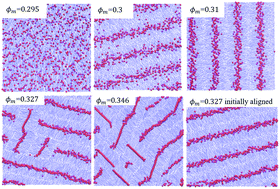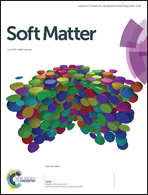Investigation of nematic to smectic phase transition and dynamical properties of strongly confined semiflexible polymers using Langevin dynamics
Abstract
We investigated the nematic to smectic phase transition for strongly confined semiflexible polymer solutions in slit-like confinements using GPU-accelerated Langevin dynamics. We characterized the phase transitions from the nematic to smectic phases for semi-flexible polymer solutions as the polymer density increased. The dependence for the lyotropic nematic to smectic transition can be collapsed by scaling exponents between 0.2 and 0.3. The smectic C phase is found for all the cases with the polymer orientation director tilted with respect to smectic layer lateral alignment. As the chain rigidity increases, the transition density decreases for systems in which the polymer persistence length (P) to slit height (H) ratios are 1.25, 2.5, 3.75, 5 and 25. We also characterized the polymer dynamics for the isotropic–nematic—smectic transitions. The overall polymer diffusivity decreased steadily as the polymer density increased. We observed anomalous polymer diffusion along the nematic director near the isotropic–nematic transition, similar to previously reported behavior for nematic-forming ellipsoids. Polymer diffusivity decreased sharply by two orders of magnitude upon the nematic–smectic transition.



 Please wait while we load your content...
Please wait while we load your content...